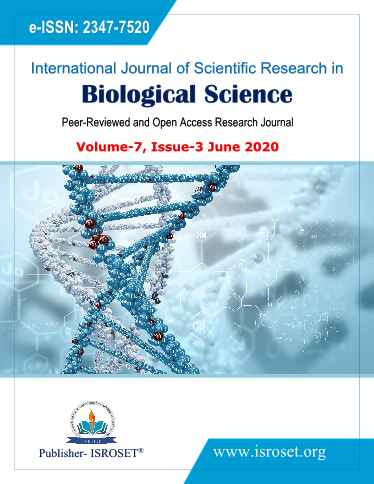Diversity and Distribution Patterns of Tree Species along Enkare Narok River, Kenya
Keywords:
Riparian, communities, species, river, diversity, disturbanceAbstract
The Enkare Narok River system features in the list of the majority of significant streams for conservation of riparian plant biodiversity but anthropogenic activities potentially threaten the formative ecosystem processes. This research paper ascertains the diversity and distribution patterns of riparian tree species in relation to the human disturbances. The procedure for collecting vegetation data involved the use of the line transects method. Transects were laid running orthogonal to the river at 20 m intervals downstream and ten plots in every transect were systematically determined, with a separation distance of 10 meters. A floristic exploration of dominant riparian tree species was done at 51 sites along a 2,250-meter stretch along Enkare Narok River from upper Narok Prisons area to lower Polung?a, in February 2018 towards the end of the dry season. A total of 198 tree species in 12 families were recorded in the Enkare Narok River system with an observed 1.4463-2.4849 Shannon diversity index and which followed a significantly diminutive trend downstream.
References
Webb, A. A., and Erskine, W.D. A practical scientific approach to riparian vegetation rehabilitation in Australia. Journal of Environmental Management 68: 329- 341, 2003.
Rabira, G. “Threats, Community Perception of Biological Resource Conservation and Solution in Dati Wolel National Park of Ethiopia,” International Journal of Scientific Research in Biological Sciences,Vol.6, Issue.6, pp.120-128, 2019
Dudgeon, D. The impacts of human disturbance on stream benthic invertebrates and their drift in North Sulawesi, Indonesia. Freshwater Biology 51:1710–29, 2006
Lorion, C.M., and Kennedy, B.P. Relationships between deforestation, riparian forest buffers and benthic macroinvertebrates in neo-tropical headwater streams. Freshw Biol 54:165–80, 2009.
Wantzen, K. M. Physical pollution: effects of gully erosion on benthic invertebrates in a tropical clear water stream. Aquat Conserv Mar Freshw Ecosys 16:733–49, 2006.
Roy, A. H., Rosemond, A. D., & Leigh, D. S., Habitat-specific responses of stream insects to land cover disturbance: Biological consequences and monitoring implications. J North Am Benth Soc 22:292–307, 2003.
Death, R.G. Disturbance and riverine benthic continues: what has it contributed to general ecology theory? River Research and Application 26:15–25, 2009.
Mligo, C. Anthropogenic disturbance on the vegetation in Makurunge woodland, Bagamoyo district, Tanzania. Tanz J Sci 37:94–108, 2011.
Shannon, C. F., Wiener, W. The Mathematical Theory of Communication. Urbana: University of Illinois Press, 1948.
Alatalo, R.V. Problems in the measurements of evenness in ecology. Oikos 37:199–204. 1981.
Mligo, C. Environmental flow assessment in Wami River sub basin, Tanzania, Vegetation survey of the ecosystem along Wami River. In: Tobey J, Robadue D (Eds). How Much Water do We Need for Nature, Livelihoods and People? 2009.
Osborne, L.L., & Kovacic, D. A. Riparian vegetated buffer strips in water quality restoration and stream management. Freshw Biol 29:243–58, 1993.
Makkay, K., Pick, F., R., & Gillespie, L. Predicting diversity versus community composition of aquatic plants at the river scale. Aquat Bot 88:338–46, 2008.
Hill, N.M., & Keddy, P.A. Prediction of rarities from habitat variables: coastal plain plants on Nova Scotian Lakeshores. Ecology 73:1852–9, 1992.
US-EPA. Methods for Evaluating Wetland Condition: Vegetation-Based Indicators of Wetland Nutrient Enrichment, 2002
Downloads
Published
How to Cite
Issue
Section
License

This work is licensed under a Creative Commons Attribution 4.0 International License.
Authors contributing to this journal agree to publish their articles under the Creative Commons Attribution 4.0 International License, allowing third parties to share their work (copy, distribute, transmit) and to adapt it, under the condition that the authors are given credit and that in the event of reuse or distribution, the terms of this license are made clear.







